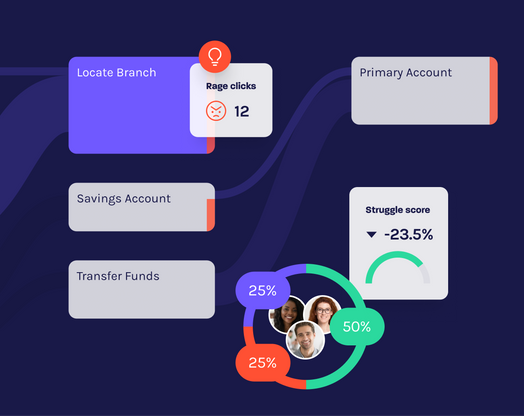
Solving Top UX Design Challenges for a Better DX
Designing a great digital experience (DX) is never a “one and done.” It takes a variety of ongoing strategies and tools to understand how a website or mobile app is performing and quickly implement improvements. But when it comes to UX design, if the right strategies and tools aren’t in place, several obstacles lie in the way of being able to create a great DX. Some of the top challenges in UX design are:
- Standard A/B tests take too long to complete and don’t show the full picture
- Data isn’t available or is siloed, making it next to impossible to make educated decisions
Solving for the top UX design challenges
Giving your UX design team access to the strategies and tools that they need so they can create frictionless customer journeys is critical. Doing so allows them to continuously improve the customer journey, fix struggles soon after they happen, or better yet, before they happen. Read on to find out how you can solve for the top UX design challenges and create a better DX.
Take A/B testing to the next level
A/B tests offer a wealth of data and analytics to drive experience improvements, but they also require a heavy lift to figure out the “why” behind it. Worse yet, this type of testing is often slow, incremental and doesn’t always lead to clear-cut answers—or a wrong conclusion based on assumptions. For A/B tests to deliver more value to the design experience, there needs to be less guesswork, fewer tests and increased efficiency.
For example, say you have a low click-through rate (CTR) on the “Next” button, which is causing conversion issues, so you change the size or color as a “fix.” The real problem, however, is that the button is “below the fold” on the website and users are missing it altogether—a conclusion you didn’t even consider as the cause of low CTR.
A powerful way to meet this common challenge is to compare the digital journey of A and B groups to understand the impact at a much more detailed level, through side-by-side interaction maps, comparing test and control.
With interaction maps, you can see exactly what users are doing on a page, typically aggregating all sessions so you can see every tap, click or scroll. For instance, if you see lots of rage clicks on a certain button, that indicates a clear problem.
Instantly, you can see what is happening, how and when, instead of making assumptions with A/B test results. These visual analytics provide the missing link to find definitive answers and come to conclusions earlier—and backed by visual data you can see with your own eyes.
Learn the benefits of combining A/B testing with digital experience analytics.
Use the data to ahead of user struggles
Another proven strategy to create a better design experience is to proactively fix potential user issues before they occur, instead of continually responding reactively. As a practical matter, analyzing real-time user behavior while it’s occurring is also more accurate and easier than designing, implementing and iterating A/B tests. Even better, you can use the data findings for continuous product design.
For example, if you observe that users open up multiple product detail page (PDP) tabs before taking action, a comparison chart could likely be a good option so users can compare features for faster and easier decisions. But you wouldn’t know this information unless you can see the behavior in action.
Interaction maps, combined with session replays can be invaluable to surface and identify these insights. Session replays show you moment by moment how your users are navigating on your website. You can see and identify root causes of issues that are causing struggles, abandonments, and the answer why they aren’t converting to customers.
With this proactive approach to user feedback, you can tailor your website to your users’ needs in less time and with fewer resources required.
Improving the user experience means going beneath surface analytics to understand the real why. Ultimately, you can make more informed decisions and implement UX changes based on what your users are experiencing—not just what might be—and deliver a streamlined, frictionless journey.
Get tips to optimize your UX design
Arming your UX design team with the tools they need is essential. Download the eBook, 9 Conversion Rate Optimization Secrets from Digital Leaders today to get the best tips, tricks and best practices to optimize your UX design and create a better digital experience for your customers.








